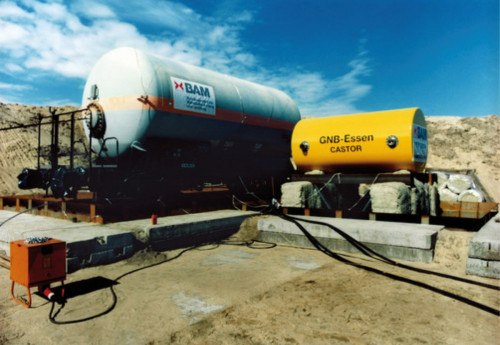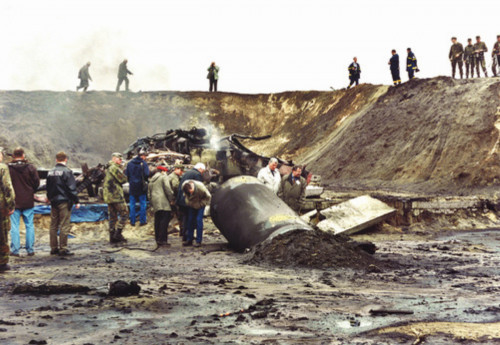For a long time, electricity generation from nuclear power plants in Germany was accompanied by citizens' initiatives as well as environmental and anti-nuclear movements. In addition to reactor safety, the storage and associated transportation of highly radioactive waste from nuclear power plants was criticized by the anti-nuclear movement [1]. In 1979, the investigation of a salt dome in Gorleben for its suitability as a final repository began. After exploration was interrupted in 2000 due to political pressure, there are now 16 interim storage facilities spread across Germany [2, 3]. Although nuclear energy is still aCO2-neutral energy source today, the decision was made to phase it out by 2022 following the accident in Fukushima due to the high risk of leaking radioactivity. Until the final phase-out, great importance will continue to be attached to reactor safety and the safety of transporting and storing spent fuel elements.
The Castor load miracle
 Test setup: Castor cask stands next to the tank wagonThetransportation of spent fuel rods in the so-called Castor casks in particular has led to numerous and emotionally charged demonstrations in the past. The name Castor stands for "Cask for Storage and Transport of Radioactive Material". They were specially developed for the transportation and storage of spent fuel elements and are intended to shield against radiation and prevent the release of radioactivity. For this purpose, they are subject to the approval and regulation of type B packaging, which is tested and approved by the Federal Office for Nuclear Waste Management (BfE) [4].
Test setup: Castor cask stands next to the tank wagonThetransportation of spent fuel rods in the so-called Castor casks in particular has led to numerous and emotionally charged demonstrations in the past. The name Castor stands for "Cask for Storage and Transport of Radioactive Material". They were specially developed for the transportation and storage of spent fuel elements and are intended to shield against radiation and prevent the release of radioactivity. For this purpose, they are subject to the approval and regulation of type B packaging, which is tested and approved by the Federal Office for Nuclear Waste Management (BfE) [4].
The casks are manufactured on behalf of Gesellschaft für Nuklear-Service GmbH (GNS) from 30-40 cm thick cast iron with spheroidal graphite. For neutron shielding and to improve the mechanical strength, polymer rods are inserted and the inside of the casks is nickel-plated. In order to ensure safety during the transportation and storage of highly radioactive waste from nuclear facilities, the Federal Institute for Materials Research and Testing (BAM), as the higher scientific and technical federal authority, has developed test procedures for testing Castor casks that deal with radiation protection on the one hand and the mechanical loads that the casks must withstand on the other. These include [2]:
- Impact from a height of 9 m on an unyielding foundation
- Impact from a height of 1 m on a 15 cm thick steel spike
- Fire (30 minutes at 800 °C)
- Pressure from 20 m water depth over eight hours
- Pressure of 200 m water depth over one hour (in addition to IAEA recommendations).
A container to be tested does not have to remain completely undamaged by the scenarios. The shielding effect may deteriorate by a maximum factor of 100 as a result of the exposure, which corresponds to a maximum radiation exposure of 10 mSv/h (millisieverts per hour at a distance of 1 m).
The containers are subjected to additional tests which must not impair their safety functions [4, 5]:
- Fall of a container from a highway bridge from a height of 40 m
- Fall of a container cooled down to -40°C from a height of 9 m
- Explosion of a liquid tank containing 5 tons of propane directly next to a container
- Fire test at 1200 °C for 30 min
- Drop of a scaled container from a helicopter from a height of 800 m
- Direct impact of a passenger train at 130 km/h on the long side of a container
- Bombardment of a container with a 1000 kg replica of an aircraft turbine shaft at 292 m/s (1050 km/h).
Radiation protection through nickel coating
 After the explosion: The Castor has been thrown out of positionIn addition tothese criteria, radiation protection is the main criterion for the casks. This is achieved by a nickel coating several millimeters thick on the inside of the containers. For this purpose, the electrolyte is filled into the cathodically switched container and galvanized with an internal anode. This increases the weight of each container by 1 ton [6]. On behalf of and with the support of GNS, the Solingen-based company Metallveredlung (MTV) developed the electroplating process NIBSORB®, a dispersion layer consisting of a ductile nickel layer with inclusions of neutron-capturing boron-containing solids [7]. The technical properties of NIBSORB®, which can be deposited in layers of any thickness, allow a wide range of applications. The homogeneous incorporation of 15-25% by volume of natural or isotope-enriched boron carbide with average grain sizes of 6-8 µm achieves effective neutron shielding that exceeds the effectiveness of previously known absorber layers even at low layer thicknesses. Further advantages are the good corrosion, wear and temperature resistance.
After the explosion: The Castor has been thrown out of positionIn addition tothese criteria, radiation protection is the main criterion for the casks. This is achieved by a nickel coating several millimeters thick on the inside of the containers. For this purpose, the electrolyte is filled into the cathodically switched container and galvanized with an internal anode. This increases the weight of each container by 1 ton [6]. On behalf of and with the support of GNS, the Solingen-based company Metallveredlung (MTV) developed the electroplating process NIBSORB®, a dispersion layer consisting of a ductile nickel layer with inclusions of neutron-capturing boron-containing solids [7]. The technical properties of NIBSORB®, which can be deposited in layers of any thickness, allow a wide range of applications. The homogeneous incorporation of 15-25% by volume of natural or isotope-enriched boron carbide with average grain sizes of 6-8 µm achieves effective neutron shielding that exceeds the effectiveness of previously known absorber layers even at low layer thicknesses. Further advantages are the good corrosion, wear and temperature resistance.
NICABOR® dispersion deposition
In 2005, the development of a nickel dispersion coating as a replacement for hard chrome was patented. This is the NICABOR® dispersion deposition [8], in which boron carbide particles with grain sizes of 1 µm are incorporated into the nickel layer in a concentration of approx. 15 %. In combination with other electrodeposited layers, e.g. nickel sulphamate or bronze as an underlayer, the coating systems achieve corrosion and wear resistance comparable to hard chrome. Large components such as piston rods, tubes or pressure cylinders should be coated with these processes in Solingen. With this process, MTV achieved a technical lead early on with regard to the chromium(VI) compounds classified as SVHC compounds by the ECHA in Annex 14 of the REACh Regulation and thus proposed for prohibition and used in hard chrome [8,9,10].
Protests against planned nickel plating plant
Although the nuclear waste transports in the Castor containers are considered safe, protests against the transports continue [9]. There have also been protests in the past against the construction of an electroplating plant in an industrial area in Solingen. While the coating of the Castor containers was relocated to Mülheim back in 2002 at the instigation of the client, GNS (Gesellschaft für Nuklear Service), the long-established contract electroplating company MTV (Metallveredlung) in Solingen wanted to use the good transport links to establish the new nickel-plating process NICABOR® and set up a plant with the new technology for other large objects in the Fürkeltrath industrial estate. In January 2008, the plan for the plant, which falls under the Hazardous Incident Ordinance, became known, which meant that the original development plan had to be adapted to the new requirements. The plans were welcomed by politicians in Solingen, as there was talk of 160 to 200 new jobs. The proximity to residential areas and organic farming as well as the height of the planned building of 30 m and the term "hazardous incident operation" made local residents sit up and take notice and they followed the city's plans closely. Eventually, they founded a citizens' initiative. From summer 2008 to March 2009, the citizens' initiative mobilized 130 owners to prevent the electroplating plant. In March 2009, there was even a threat of legal action. The organic farmers feared for their livelihoods, as the proximity to the electroplating plant would have meant regular soil samples and high costs. In addition, there was the constant fear that the soil could become enriched with nickel. The mood escalated until summer 2010, when local residents expressed their "fear of permanent exposure to heavy metals and possible accidents". In April 2011, it finally became known that MTV owner Klaus Wilbuer had abandoned the plans from a business perspective and that the politicians in Solingen had bowed to the demands of the citizens' initiative [11].
The Castor transports accompanied by protests are a symbol of the fading nuclear age in Germany. In addition to solid cast iron, a thick nickel coating is essential for the radiation protection of the nuclear waste containers. An electroplating company wanted to use a similar galvanic process to coat large components - and got caught up in the maelstrom of protests and threats of legal action.
Photos: BAM [5]
Literature
[1] https://de.wikipedia.org/wiki/Kernenergie_in_Deutschland#Geschichte
[2] https://www.ndr.de/geschichte/schauplaetze/Gorleben-und-der-Atommuell-Eine-Chronik,gorlebenchronik2.html
[3] https://www.rnd.de/politik/wo-der-atommull-in-deutschland-liegt-I6EOB4MGERGZBJPGKMQHVCOHAA.html
[4] Wikipedia Castor (nuclear technology)
[5] https://tes.bam.de/TES/Navigation/DE/Gefahrgut/Behaelter-radioaktive-Stoffe/Pruefmethoden-und-Forschung/pruefmethoden-und-forschung.html
[6] Welt am Sonntag, Solinger Firma macht Castor sicherer, 16.04.2006
[7] NIBSORB®; www.mtv-gmbh.com
[8] NICABOR®; www.mtv-gmbh.com
[9] Why not compromise, Heiko Reski, MTV Metallveredlungs GmbH & Co. KG, Solingen, WoMag 9 (2016), p. 1-2
[10] Customized hybrid coating systems, Heiko Reski, MTV Metallveredlungs GmbH & Co. KG, Solingen, JOT Kombinierte Oberflächen, X (2016), p. 20
[11] www.maschinenmarkt.vogel.de, 11.02.2014, editor Carmen Kural, Chromersatz mit hoher Korrosionsbeständigkeit
[12] https://castor-stoppen.de/buendnis/
[13] Article from the Solingen city archives from 27.4.2002 - 27.05.2011 on the terms citizens' initiative and metal finishing


